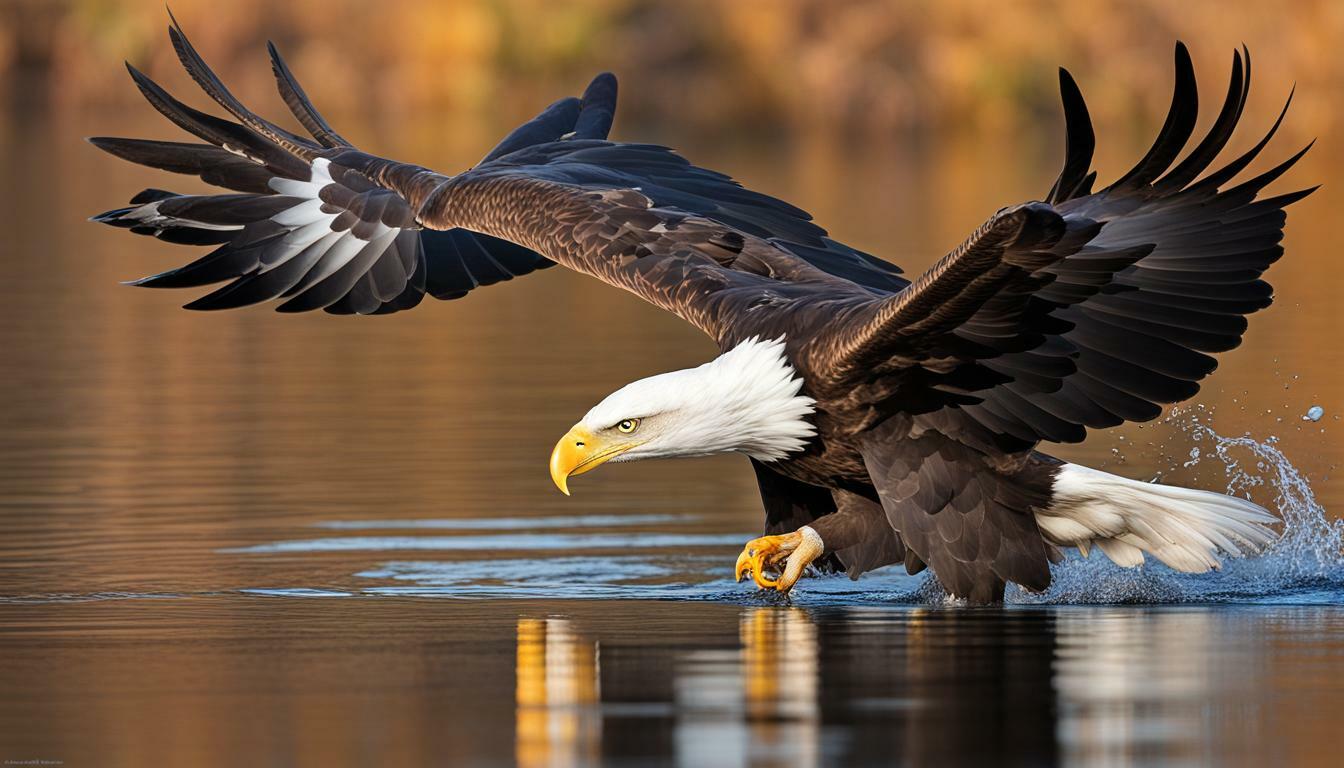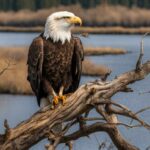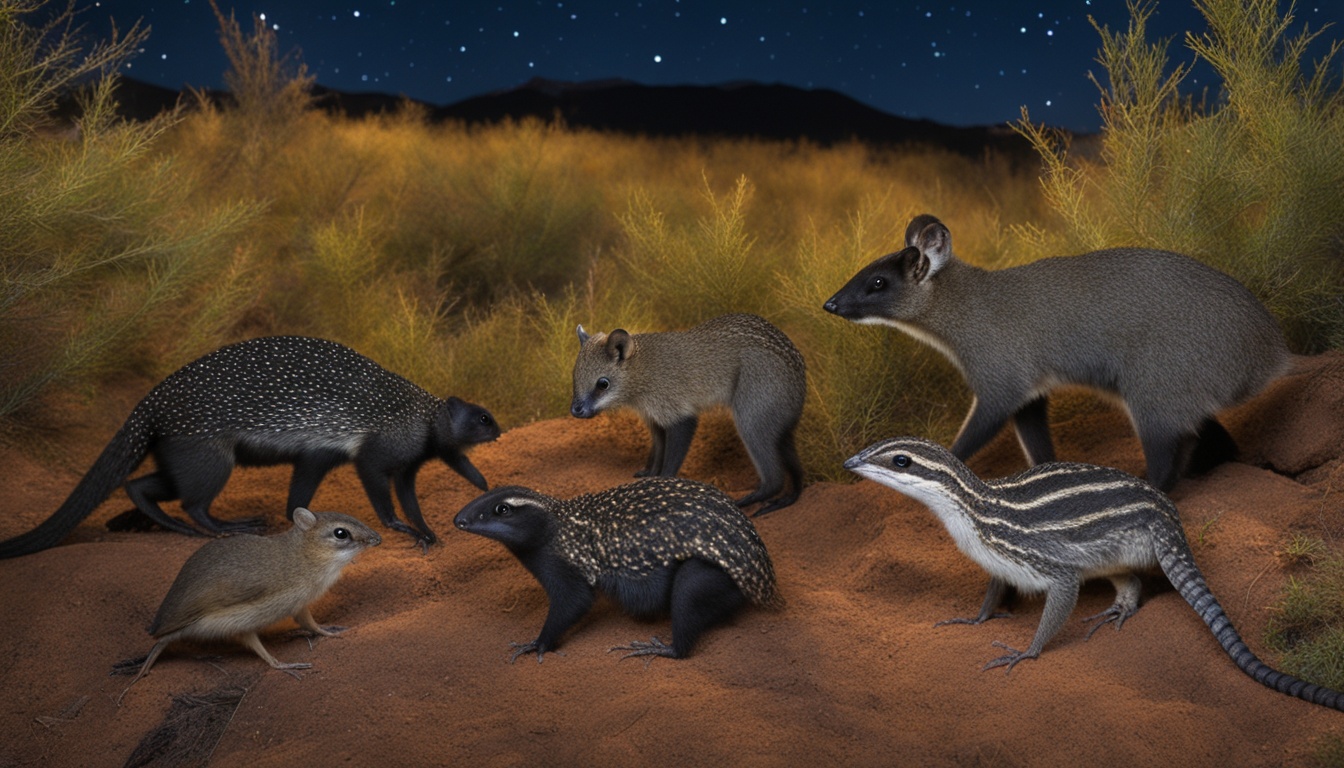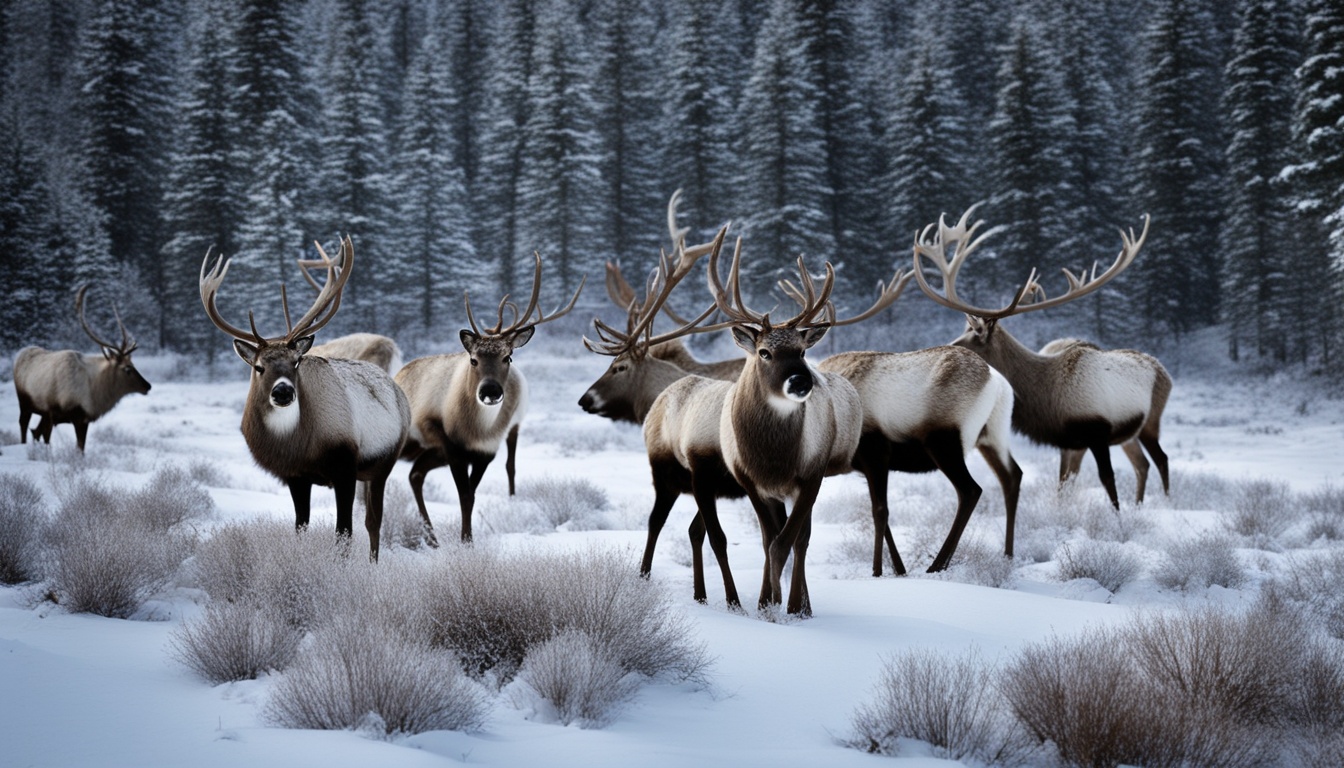Have you ever wondered what bald eagles eat? These majestic birds of prey are renowned for their impressive hunting abilities and are often depicted in popular culture as symbols of strength and power. However, did you know that their diet primarily consists of fish?
Bald eagles are skilled hunters with sharp talons and beaks, which they use to catch and consume a wide variety of fish species found in their natural habitats. From freshwater fish like salmon, trout, and catfish to saltwater species like herring, cod, and flounder, bald eagles can adapt to different environments and feeding habits to ensure their survival.
In this article, we will explore the different types of fish that bald eagles prefer to eat, their feeding habits, and the impact of habitat and seasonal availability on their food choices. We will also discuss the occasional inclusion of other prey items in their diet and the importance of conservation efforts to ensure their survival.
Key Takeaways:
- Bald eagles primarily eat fish.
- They are skilled hunters with sharp talons and beaks.
- They can adapt to different environments and feeding habits to ensure their survival.
- Their diet is influenced by habitat and seasonal availability.
- Conservation efforts are crucial for their survival.
Bald Eagle Diet: A Closer Look
When it comes to food preferences, bald eagles are known for their impressive appetite for fish, comprising up to 70-90% of their diet. These magnificent hunters are often seen swooping down to the water’s surface to capture their prey with sharp talons. But what types of fish do bald eagles prefer to eat?
| Type of Fish | Description |
|---|---|
| Salmon | One of the most commonly consumed fish species by bald eagles, particularly during spawning season. They are drawn to the oily flesh and high protein content of salmon. |
| Trout | Another popular choice for bald eagles, trout can be found in both fresh and saltwater environments. They are known for their high nutritional value, providing the eagles with essential nutrients such as omega-3 fatty acids. |
Besides these two types of fish, bald eagles also consume a variety of other freshwater and saltwater species, such as herring, bass, catfish, and flounder. Interestingly, they have also been known to eat seagulls, cormorants, and other birds that forage for fish, and even small mammals like rabbits and rodents.
The reasons behind the bald eagle’s food preferences are multifaceted. For one, different species of fish provide varying nutritional value and can be found in different habitats. They are also influenced by seasonal availability, with some fish species being more abundant during certain times of the year.
Bald Eagle Adaptations for Fish Consumption
In order to catch and consume fish effectively, bald eagles have evolved a number of adaptations that make them skilled hunters. Their sharp talons and beak allow them to grasp and tear apart their prey with ease. They also have a specialized digestive system that allows them to extract nutrients from fish, even consuming bones and scales.
Overall, the bald eagle’s diet primarily consists of fish, but they are adaptable and opportunistic hunters, occasionally incorporating other prey items into their diet. This diverse and flexible diet enables them to thrive in a range of habitats, from coastal areas to freshwater lakes and rivers.
Feeding Habits of Bald Eagles
As a top-of-the-food-chain predator, bald eagles have developed incredible hunting skills that enable them to catch a wide variety of prey, including fish.
When hunting for food, bald eagles primarily rely on their exceptional eyesight to spot prey from a distance. They may perch on trees or high rocks overlooking water bodies or fly over the water searching for fish. Once they spot a potential meal, they swoop down and snatch it out of the water with their sharp talons. They can take fish weighing up to 4 pounds.
Bald eagles are also opportunistic feeders and will scavenge for food when necessary. They will feed on carrion, or dead animals, either found near the water on shores or lakes or along roadsides.
Impact of Habitat on Bald Eagles’ Food Choices
Bald eagles are opportunistic hunters that prioritize fish as their main source of food. Their diet varies depending on the availability of prey in their habitat, which can influence their feeding habits and preferences. The quality of their habitat is essential to their survival, as it affects their ability to hunt and access the fish they need to thrive.
You may wonder: what types of fish do bald eagles prefer?
The answer varies depending on the region where they live. Bald eagles have been known to consume over 80 different species of fish, with some preferences in certain areas. For instance, in the Pacific Northwest, bald eagles tend to consume salmon, herring, and smelt. On the other hand, in the Chesapeake Bay area, they feed mainly on catfish, white perch, and striped bass. A bald eagle’s diet can also change depending on seasonal variations in the supply of different fish species.
But, why are some fish species preferred over others?
Bald eagles typically target fish that are easily accessible and abundant in their environment. They also prefer fish that are large enough to provide a substantial meal and are high in nutrients. Fish with softer and more oily flesh are also more attractive, as they provide more energy and are easier to digest. For example, bald eagles in coastal areas may consume seabirds that feed on oily fish, as they have more energy-rich meals.
Fun fact: Bald eagles can consume up to 1 pound of fish in one meal!
So, how does habitat affect bald eagles’ food choices?
If the quality of the habitat declines, bald eagles’ prey populations can suffer, which can make it harder for them to find the food they need. Human activities like pollution and fishing can also impact fish populations and make it harder for bald eagles to maintain their preferred diet. Therefore, the preservation of bald eagles’ habitats is critical to ensure their continued survival and access to the fish they need to thrive.
In conclusion, the quality of a bald eagle’s habitat plays a significant role in determining their food choices, including the types of fish they prefer to consume. By understanding their natural feeding habits and conservation needs, we can take the necessary measures to protect these magnificent birds and their habitats for generations to come.
Bald Eagles and Freshwater Fish
Did you know that bald eagles are known to prefer freshwater fish as their primary source of food? These birds of prey have a variety of fish species to choose from in their freshwater habitats, but some are more attractive prey than others.
| Freshwater Fish Species Bald Eagles Frequently Consume | Why They Are Attractive Prey for Bald Eagles |
|---|---|
| Salmon | High in fat and protein, often plentiful during salmon runs |
| Trout | Abundant in many freshwater habitats, slow-moving and easy to catch |
| Bass | Found in both lakes and rivers, often large and easy to spot |
Bald eagles’ preference for freshwater fish is partly due to the abundance of these species in their habitats. These birds of prey are skilled hunters and can easily snatch fish from the water’s surface with their sharp talons.
However, their diet can also be impacted by the seasonal availability of certain fish species. For example, during the winter months, they may rely more heavily on fish species that are available in colder waters.
Overall, bald eagles and freshwater fish have a special relationship, with these magnificent hunters relying heavily on the health of their freshwater habitats to survive.
Bald Eagles and Saltwater Fish
While bald eagles primarily hunt for freshwater fish, they have been known to occasionally consume saltwater fish as well. Along the coast, bald eagles can be seen feeding on fish such as herring, salmon, and rockfish. These fish are attracted to estuaries where freshwater and saltwater mix, making them easily accessible to bald eagles.
When hunting for saltwater fish, bald eagles have to adapt to the marine environment. They may soar over the ocean looking for fish to catch, or perch on rocky cliffs and scan the water for potential prey. Once they spot a fish, they swoop down and snatch it out of the water with their talons.
Interestingly, bald eagles have a gland above their eyes that filters out the excess salt from the fish they eat, making it possible for them to consume saltwater prey without issue. This adaptation allows the birds to expand their food options and thrive in coastal areas.
Bald Eagles and Seasonal Fish Availability
The diet of bald eagles varies according to the availability of fish species in their habitat, which is greatly influenced by the changing seasons. In certain regions, bald eagles may migrate to follow the movements of their preferred fish species, while in others, they may adapt their hunting techniques to target different types of fish during the winter months.
During the fall, bald eagles may consume a range of fish species, including salmon, trout, and herring, which are often abundant in rivers and estuaries. As winter approaches and these species become scarcer, bald eagles may shift their attention to other fish species like cod, halibut, and shellfish. In some cases, they may also rely on scavenging for carrion or feeding on small mammals like rabbits and rodents.
However, during the spring, bald eagles typically return to consuming their preferred fish species, including salmon and herring, as these species migrate back to their spawning grounds. In the summer months, bald eagles may target smaller fish species like smelt and stickleback, which are abundant in shallow waterways.
Overall, the seasonal availability of different fish species greatly influences the diet of bald eagles, and their hunting patterns and techniques are often adapted to suit the changing conditions in their habitat.
Bald Eagles and Other Prey
While bald eagles are primarily known for their fish consumption, they may occasionally include other prey items in their diet. Their diet can vary depending on the availability of their preferred food sources and their hunting success.
Small mammals such as rabbits, rodents, and squirrels may be targeted by bald eagles, particularly when fish are scarce or harder to catch. Waterfowl such as ducks and geese may also be on the menu, especially during the winter months when they congregate in large numbers.
Bald eagles are also skilled scavengers, often feeding on carrion or leftover scraps from other predators. They have been known to scavenge from roadkill, garbage dumps, and fishing vessels.
Despite these occasional dietary diversions, fish remains the essential component of their diet and the primary source of their nutritional needs.
Bald Eagles and Human Interaction
As a top predator specializing in fish consumption, bald eagles play a crucial role in maintaining a healthy ecosystem. However, human activities like fishing and pollution can significantly impact the availability and quality of fish for bald eagles, ultimately affecting their food preferences.
Overfishing, for instance, can lead to the depletion of certain fish species that bald eagles rely on, forcing them to seek alternative prey. Pollution, on the other hand, can introduce toxins to the fish that bald eagles consume, posing a serious threat to their health and survival.
To ensure the continued survival of bald eagles, it is essential to take active measures to preserve their habitats and protect the fish species they depend on. This can involve implementing sustainable fishing practices and reducing pollution levels in water bodies.
By prioritizing conservation efforts, we can help ensure that bald eagles continue to thrive and fulfill their vital ecological role for generations to come.
Conclusion
Congratulations! You now have a greater understanding of the bald eagle’s diet and feeding habits. As you have learned, bald eagles primarily consume fish, with freshwater species being their preferred prey. However, they also occasionally consume saltwater fish and other prey items like small mammals, waterfowl, and carrion.
The availability of different fish species in their habitat plays a significant role in their food choices, and their diet can vary according to the changing seasons. It’s essential to preserve their habitats and limit human activities like fishing and pollution to ensure that they have access to a healthy ecosystem and a steady supply of fish.
We hope this article has provided you with valuable insights into the world of bald eagles and their impressive hunting abilities. If you ever have the chance to witness these magnificent hunters in action, take a moment to appreciate their prowess and the crucial role they play in our ecosystem.
Why Don’t Bald Eagles Live in Hawaii?
Hawaii’s pristine tropical paradise is home to various avian species, yet it seems there are no bald eagles in hawaii. This absence can be attributed to the geographical isolation of the islands, preventing these majestic birds from ever reaching the archipelago. So, unfortunately, no bald eagles in Hawaii to grace its skies with their iconic presence.
FAQ
Q: What is the bald eagle’s diet?
A: The bald eagle’s diet primarily consists of fish.
Q: What type of fish do bald eagles eat?
A: Bald eagles eat a variety of fish species, including trout, salmon, and herring.
Q: How do bald eagles catch their prey?
A: Bald eagles are skilled hunters and catch their prey by swooping down from the sky or snatching fish from the water’s surface.
Q: Do bald eagles eat other animals besides fish?
A: While fish is the main component of their diet, bald eagles may also consume small mammals, waterfowl, and carrion when available.
Q: How does habitat affect the bald eagle’s food choices?
A: The availability of different fish species in their habitat influences the prey choices of bald eagles.
Q: Where do bald eagles prefer to find their food?
A: Bald eagles prefer to hunt near bodies of water, such as rivers, lakes, and coastal areas where fish are abundant.
Q: Do bald eagles consume saltwater fish?
A: Yes, bald eagles occasionally consume saltwater fish, especially in coastal areas where they adapt to marine environments.
Q: How do seasonal fish availability affect the bald eagle’s diet?
A: Bald eagles’ hunting patterns change according to the seasons and the availability of certain fish species.
Q: How do human activities impact the bald eagle’s diet?
A: Human activities like fishing and pollution can affect the availability and quality of fish for bald eagles.
Q: What is the importance of conserving bald eagle habitats?
A: Conserving bald eagle habitats is crucial for their survival as these magnificent hunters rely on healthy ecosystems and abundant fish populations.











